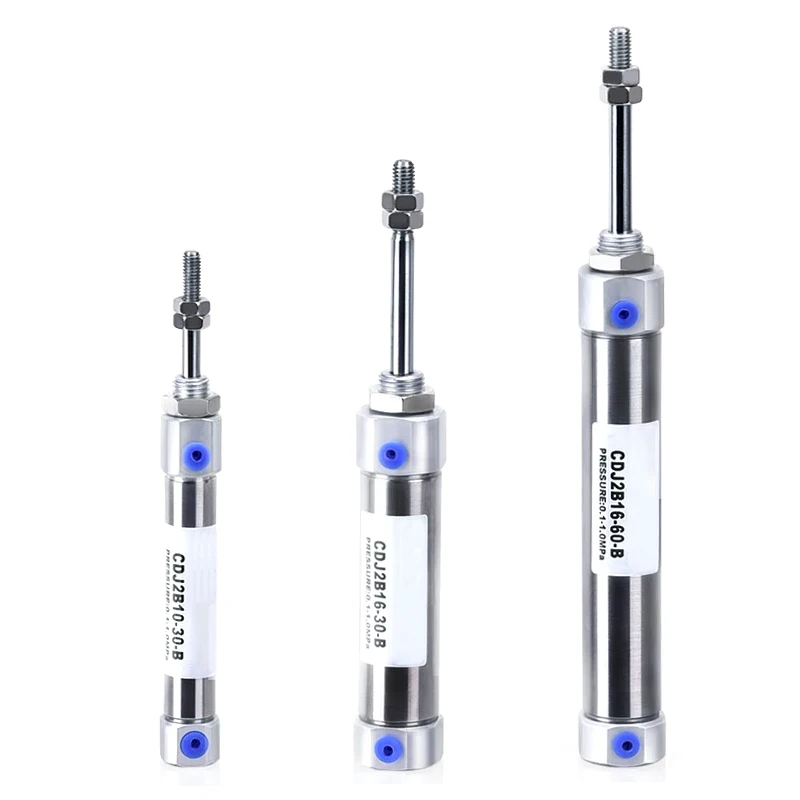Industrial automation systems rely heavily on precision and smooth operation to maintain efficiency and reduce wear on critical components. One of the most effective ways to enhance system performance is through proper cushioning techniques for pneumatic cylinders. This essential process helps minimize impact forces, reduce noise levels, and extend equipment lifespan while ensuring consistent operational reliability across various industrial applications.

Modern manufacturing environments demand precise control over mechanical systems, and understanding how to implement effective cushioning solutions can significantly impact overall production quality. When properly executed, cushioning techniques transform harsh mechanical impacts into controlled, gradual deceleration processes that protect both the pneumatic cylinder and surrounding equipment from damage.
Understanding Pneumatic Cylinder Cushioning Fundamentals
Basic Principles of Cushioning Technology
Cushioning in pneumatic systems works by gradually restricting airflow as the piston approaches the end of its stroke. This controlled restriction creates a back-pressure that slows the piston movement, preventing sudden stops that could damage internal components or create excessive vibration throughout the system. The effectiveness of this process depends on several critical factors including cylinder design, operating pressure, and load characteristics.
The fundamental concept involves creating a variable restriction in the exhaust port as the piston nears its end position. This restriction forces the compressed air to escape more slowly, creating a cushioning effect that absorbs kinetic energy gradually rather than allowing abrupt impacts. Understanding this principle is essential for selecting appropriate cushioning methods for specific applications.
Types of Cushioning Mechanisms
Built-in cushioning systems are integrated directly into the cylinder design and offer consistent performance across varying operating conditions. These systems typically feature adjustable needle valves that allow fine-tuning of cushioning intensity based on load requirements and operating speeds. The adjustment capability makes them suitable for applications where operating parameters may change over time.
External cushioning solutions provide flexibility for existing pneumatic cylinder installations where built-in systems are not available. These solutions include flow control valves, shock absorbers, and specialized cushioning chambers that can be retrofitted to enhance system performance without requiring complete equipment replacement.
Implementation Strategies for Effective Cushioning
Flow Control Valve Configuration
Installing flow control valves in the exhaust lines represents one of the most common and effective cushioning methods. These valves create controlled restrictions that slow piston movement as it approaches end positions. The key to successful implementation lies in proper valve sizing and positioning to ensure optimal cushioning without compromising cycle times or system efficiency.
Bi-directional flow control valves offer enhanced flexibility by allowing independent adjustment of cushioning for both extension and retraction strokes. This capability is particularly valuable in applications where loads differ significantly between operating directions or where precision positioning requirements vary throughout the operational cycle.
Shock Absorber Integration
External shock absorbers provide excellent cushioning performance for heavy-duty applications where standard flow control methods may be insufficient. These devices absorb kinetic energy through hydraulic or mechanical means, offering consistent performance regardless of load variations or operating speed changes. Proper selection requires careful consideration of energy absorption capacity and mounting requirements.
When integrating shock absorbers, mounting alignment becomes critical to ensure proper force transmission and prevent binding or misalignment issues. The shock absorber must be positioned to engage at the appropriate point in the stroke cycle, allowing sufficient travel distance for effective energy absorption while maintaining system precision.
Advanced Cushioning Techniques and Technologies
Pneumatic Cushioning Chambers
Specialized cushioning chambers create dedicated volumes for compressed air management during deceleration phases. These chambers work by capturing and gradually releasing compressed air through precisely calibrated orifices, providing smooth and consistent cushioning performance. The chamber size and orifice design must be matched to specific application requirements for optimal results.
Variable volume cushioning chambers offer advanced control capabilities by allowing real-time adjustment of cushioning characteristics based on operating conditions. This technology is particularly beneficial in automated systems where load conditions or speed requirements may change frequently throughout production cycles.
Electronic Cushioning Control Systems
Modern electronic control systems enable precise cushioning management through proportional valve control and feedback sensors. These systems monitor piston position and velocity in real-time, adjusting cushioning parameters automatically to maintain optimal performance across varying operating conditions. Integration with existing automation systems allows for sophisticated cushioning profiles tailored to specific application requirements.
Programmable cushioning controllers offer the flexibility to create custom deceleration profiles that optimize both protection and productivity. These systems can store multiple profiles for different products or operating modes, automatically switching between configurations as production requirements change.
Optimization and Maintenance Considerations
Performance Tuning Methods
Achieving optimal cushioning performance requires systematic adjustment and testing procedures. Initial settings should be conservative to prevent damage, with gradual adjustments made while monitoring system behavior under actual operating conditions. Regular performance evaluation helps identify opportunities for improvement and ensures consistent operation over time.
Load testing under various operating conditions validates cushioning effectiveness and identifies potential issues before they impact production. Documentation of optimal settings for different operating scenarios facilitates quick adjustments when production requirements change and helps maintain consistent performance across multiple shifts or operators.
Preventive Maintenance Protocols
Regular inspection of cushioning components prevents unexpected failures and maintains system reliability. Key maintenance activities include checking valve settings, inspecting seals and connections, and verifying proper alignment of external cushioning devices. Scheduled maintenance intervals should be based on operating hours and environmental conditions rather than arbitrary time periods.
Component replacement schedules must account for the increased wear that can occur in cushioning systems due to their role in energy absorption. Proactive replacement of wear components prevents sudden failures that could damage the pneumatic cylinder or surrounding equipment while maintaining optimal cushioning performance throughout the service life.
Troubleshooting Common Cushioning Issues
Identifying Performance Problems
Inadequate cushioning often manifests as excessive noise, vibration, or visible impacts at stroke endpoints. These symptoms indicate that cushioning systems require adjustment or that additional cushioning capacity may be needed. Systematic diagnosis involves evaluating operating pressures, load characteristics, and cushioning component condition to identify root causes.
Excessive cushioning can be equally problematic, causing slow cycle times or incomplete strokes that impact productivity. Balancing cushioning effectiveness with operational efficiency requires careful attention to system dynamics and may involve iterative adjustment processes to achieve optimal performance.
Solution Implementation Strategies
Resolving cushioning issues often requires a combination of adjustment and component modification approaches. Simple adjustments to flow control settings may resolve minor issues, while more significant problems might require upgrading to higher-capacity cushioning systems or implementing multiple cushioning methods simultaneously.
System modifications should be implemented gradually with careful monitoring of results to ensure that improvements in one area do not create new problems elsewhere. Documentation of changes and their effects facilitates future troubleshooting efforts and helps establish best practices for similar applications.
FAQ
What are the most common signs that a pneumatic cylinder needs better cushioning
The most obvious indicators include loud banging noises at the end of strokes, excessive vibration transmitted through mounting structures, visible bouncing or rebounding of the piston rod, and premature wear of seals or internal components. Additionally, if you notice decreased positioning accuracy or consistency in cycle times, inadequate cushioning may be contributing to these issues. Regular monitoring of these symptoms helps prevent more serious damage and maintains optimal system performance.
How do I determine the right cushioning method for my specific application
Selection depends on several key factors including operating pressure, load weight and characteristics, required cycle speed, positioning accuracy requirements, and available space for cushioning components. Light-duty applications often benefit from simple flow control valves, while heavy-duty or high-speed operations may require dedicated shock absorbers or built-in cushioning systems. Consulting with pneumatic system specialists and conducting load analysis helps ensure proper component selection for optimal performance.
Can I add cushioning to an existing pneumatic cylinder that was not originally designed with it
Yes, external cushioning solutions can be retrofitted to most existing pneumatic cylinders. Options include installing flow control valves in exhaust lines, adding external shock absorbers, or implementing cushioning chambers. The specific approach depends on available mounting space, plumbing configuration, and performance requirements. Retrofit solutions often provide significant improvement in system smoothness and component longevity without requiring complete cylinder replacement.
How often should cushioning systems be inspected and maintained
Inspection frequency should be based on operating hours and environmental conditions rather than calendar intervals. High-duty cycle applications may require monthly inspections, while lighter-duty systems might need attention only quarterly. Key maintenance activities include checking adjustment settings, inspecting seals and connections, verifying proper alignment, and testing cushioning effectiveness under actual operating conditions. Keeping maintenance logs helps identify patterns and optimize inspection intervals for maximum reliability.
Table of Contents
- Understanding Pneumatic Cylinder Cushioning Fundamentals
- Implementation Strategies for Effective Cushioning
- Advanced Cushioning Techniques and Technologies
- Optimization and Maintenance Considerations
- Troubleshooting Common Cushioning Issues
-
FAQ
- What are the most common signs that a pneumatic cylinder needs better cushioning
- How do I determine the right cushioning method for my specific application
- Can I add cushioning to an existing pneumatic cylinder that was not originally designed with it
- How often should cushioning systems be inspected and maintained

